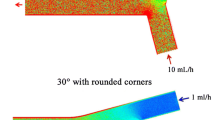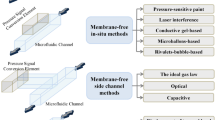Abstract
In this work, we present a way to make rheological measurements on a microfluidic chip. The originality of our approach relies on the determination of the flow curve of a fluid using the Rabinowitsch–Mooney equation. For this purpose, we use a parallel flow between a reference fluid and a studied fluid to measure the pressure drop inside the channel. Using a Newtonian fluid of known viscosity, knowing the flow rates of the two liquids and measuring the geometrical features of the two-phase flow allows determining the pressure drop in the channel. The Rabinowitsch–Mooney equation is used to calculate the local shear rate and shear stress at the wall for the studied sample. We validate our method for several complex fluids.








Similar content being viewed by others
References
Abgrall P, Nguyen NT (2008) Nanofluidic devices and their applications. Anal chem 80(7):2326–2341
Bagley E (1957) End corrections in the capillary flow of polyethylene. J Appl Phys 28:624
Berret J-F, Porte G, Decruppe J-P (1997) Inhomogeneous shear flows of wormlike micelles: a master dynamic phase diagram. Phys Rev E 55:1668
Clasen C, McKinley GH (2004) Gap-dependent microrheometry of complex liquids. J Non Newton Fluid Mech 124(1):1–10
Chevalier J, Ayela F (2008) Microfluidic on chip viscometers. Rev Sci Instrum 79:076102
Dhinojwala A, Granick S (1997) Micron-gap rheo-optics with parallel plates. J Chem Phys 107:8664
Forgiarini A, Esquena J, Gonzalez C, SolansC (2001) Formation of nano-emulsions by low-energy emulsification methods at constant temperature. Langmuir 17:2076
Gachelin J, Miño G, Berthet H, Lindner A, Rousselet A, Clément É (2013) Non-Newtonian viscosity of Escherichia coli suspensions. Phys Rev Lett 110(26):268103
Galambos P, Forster F (1998) An optical micro-fluidic viscometer. ASME international mechanical engineering congress and exposition, Anaheim, CA, pp 187–191
Guillot P, Panizza P, Salmon J-B, Joanicot M, Colin A, Bruneau C-H, Colin T (2006) Viscosimeter on a microfluidic chip. Langmuir 22:6438
Howard SJ, Ober TJ, Oliveira MS, Alves MA, McKinley GH (2012) Extensional rheology and elastic instabilities of a wormlike micellar solution in a microfluidic cross-slot device. Soft Matter 8(2):536–555
Kang K, Lee LJ, Koelling KW (2005) High shear microfluidics and its application in rheological measurement. Exp Fluids 38:222
Kang YJ, Yoon SY, Lee K-H, Yang S (2010) A highly accurate and consistent microfluidic viscometer for continuous blood viscosity measurement. Artif Organs 34:944
Kang YJ, Yang S (2013) Integrated microfluidic viscometer equipped with fluid temperature controller for measurement of viscosity in complex fluids. Microfluidics Nanofluidics 14:657
Lee J, Tripathi A (2005) Intrinsic viscosity of polymers and biopolymers measured by microchip. Anal Chem 77:7137
Lenk R (1978) The Hagen–Poiseuille equation and the Rabinowitsch correction. The pressure drop in tapered channels, in Polymer Rheology. Springer, New York, pp 750–785
Macosko C (1994) Rheology: principles, measurements, and applications. Wiley-VCH, Poughkeepsie, NY
Mortensen NA, Okkels F, Bruus H (2005) Reexamination of Hagen Poiseuiille flow: shape dependence of the hydraulic resistance in micro channels. Phys Rev E71:057301
Nghe P, Fielding SM, Tabeling P, Ajdari A (2010) Interfacially driven instability in the microchannel flow of a shear-banding fluid. Phys Rev Lett 104(24):248303
Nguyen N-T, Yap Y-F, Sumargo A (2008) Microfluidic rheometer based on hydrodynamic focusing. Meas Sci Technol 19:085405
Pipe CJ, McKinley GH (2009) Microfluidic rheometry. Mech Res Commun 36:110
Salmon JB, Colin A, Manneville S, Molino F (2003) Velocity profiles in shear-banding wormlike micelles. Phys Rev Lett 90:228303
Solomon DE, Vanapalli SA (2013) Multiplexed microfluidic viscometer for high-throughput complex fluid rheology. Microfluid Nanofluid. doi:10.1007/s10404-013-1261-2
Acknowledgments
The authors gratefully acknowledge support from the Aquitaine Région.
Author information
Authors and Affiliations
Corresponding author
Rights and permissions
About this article
Cite this article
Guillot, P., Colin, A. Determination of the flow curve of complex fluids using the Rabinowitsch–Mooney equation in sensorless microrheometer. Microfluid Nanofluid 17, 605–611 (2014). https://doi.org/10.1007/s10404-013-1329-z
Received:
Accepted:
Published:
Issue Date:
DOI: https://doi.org/10.1007/s10404-013-1329-z




